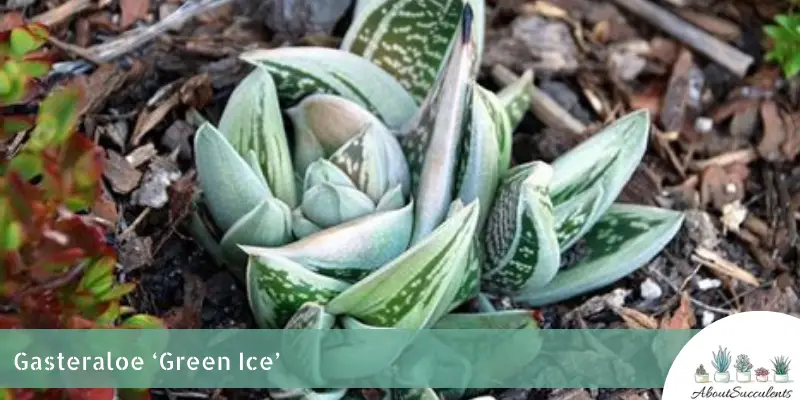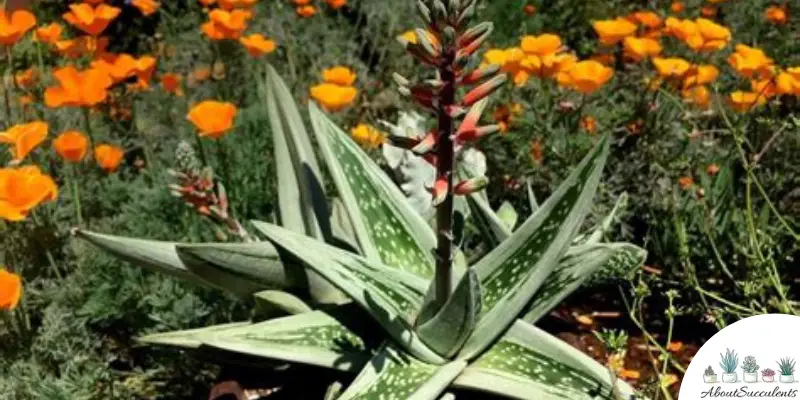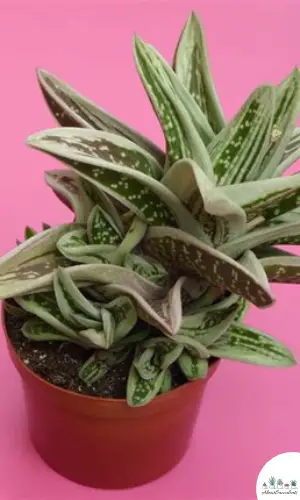
Gasteraloe ( Green Ice ) is a peculiar-looking succulent probably because it’s a hybrid of Gasteria and Aloe succulent plants.
Green Ice gets its name from the cool, lime-green color of its thick, fleshy leaves that are dotted with white marking and have jagged edges. A fully-grown Green Ice can reach a height and width of 30cm (12”).
In the summertime, you will be rewarded with small, tubular-shaped flowers that have red and green colors if properly cared for.
As a hybrid succulent, Gasteraloe is believed to have originated in South Africa. Green Ice is a member of the Asphodelaceae family.
General Information
Also known as: Green Ice
Plant Family: Asphodelaceae
Origin: South Africa
Height: 30cm (12”)
Exposure: Partial sun for up to 6 hours.
Water needs: Follow the soak and dry method where the soil is given a thorough soaking and the next watering schedule is only when the soil is completely dry..
Soil Type: Well-draining cactus soil mix with pumice, perlite, or coarse sand added for better drainage.
Soil pH: 5.0 to 7.0
How to Grow and Care for Gasteraloe ( Green Ice )

If you’re thinking about sprucing up your outdoor garden, you can start off by growing Gasteraloe Green Ice. Popularly grown as perennials in a rock garden, Green Ice is easy to care for.
This type of succulent plant isn’t cold-hardy. If the temperature in your region drops below -1.1° C (30° F), you can grow Green Ice in a pot and use it to adorn your outdoor patio. Then when the weather gets frosty, move the succulent indoors.
The rule of thumb in growing and caring for Gasteraloe is “neglect is best”. The great thing about succulents is that the less you do for them, the more they thrive.
Sunlight
Gasteraloe needs to get its regular dose of rays but it does better to partial sunlight rather than full sunlight.
Position Green Ice in a location in the garden where it can get 6 hours of partial sunlight every day. Make sure that it’s morning or late afternoon sun. Exposing the succulent plant to the harsh rays of the mid-afternoon sun can burn its leaves.
As a houseplant, place the pot near a window that receives 6 hours of partial sunlight per day. If this isn’t possible or if you prefer to display the Green Ice in another area, buy a Grow Light and give the plant the required amount of light exposure.
Not giving Gasteraloe enough sunlight will result in etiolation where the leaves stretch out and become withered and weak.
Watering

Have you seen movies where the actor constantly sprays the succulents with water? The scriptwriters probably don’t grow succulent plants.
First, succulents don’t require frequent watering. This includes Gasteraloe. If you water Green Ice too much, its roots will rot and this will lead to a fungal infection that could kill your plant.
When it comes to watering, follow the soak and dry method. Check the moisture level of the soil by using a Hygrometer or by simply inserting a stick into the topsoil.
If the stick comes out dry, give the soil a thorough soaking. Don’t water again until the soil is completely dry.
The second mistake shown in the movies is watering the succulents from above. Always water the soil and never the plant. Succulents store water in their leaves and stems. Watering the plant will only keep it moist for a longer period of time.
The frequency of watering will depend on the season. Expect to water more during the summer season where the soil dries up faster and less during the winter months.
Pot and Soil
It’s not just frosty temperatures that you should worry about when it comes to growing Gasteraloe.
As mentioned earlier, overwatering is bad for Green Ice. If it frequently rains in your area, it would be best to grow the succulent in a pot that can be transferred indoors or in a shaded area.
The best pot would be one that’s made of unglazed ceramic or terracotta because these materials allow excess moisture to evaporate from the soil. Make sure the pot has drain holes at the bottom.
Place a tray underneath the pot to collect the excess water. Always discard the excess water from the tray. Otherwise, the roots will be sitting on top of water.
Choose well-draining and aerated soil for Green Ice. The ideal type of soil is cactus mix with a pH level of 5.0 to 7.0 Add perlite, coarse sand, or pumice to improve the quality of drainage.
How to Propagate Gasteraloe ( Green Ice )
Gasteraloe ( Green Ice ) grows offsets near the base of the main plant that will make it easy for you to add to your succulent garden.
Another method of propagation is through the use of its leaves. Make sure you remove the leaf cleanly. If any part of the leaf is left on the stem, propagation will not be successful.
Method 1 – Offsets
Step 1: Gently pull out the offsets or cut them off with a sterilized knife or garden shears.
Step 2: Leave the offsets in a warm area to dry out and develop calluses. This process will take around 1 to 2 days.
Step 3: When the offsets have formed calluses, plant them in well-draining soil.
Step 4: Keep the soil lightly moistened until such time that the offsets have taken root.
Step 5: Once the offsets are firmly rooted, give the soil water only when it’s 100% dry.
Method 2 – Leaves
Step 1: Select a healthy leaf, preferably near the main plant.
Step 2: Cut the leaf with a sterilized knife or perform a clean twist and pull.
Step 3: Place the leaves in a warm area for 2 to 3 days until they have dried out and formed calluses.
Step 4: Place the callused leaves on top of well-draining cactus soil.
Step 5: Lightly mist the soil until the leaves have formed roots.
Step 6: When the roots have taken hold of the soil, only water when the soil has gone dry.
Frequently Asked Questions
Is Gasteraloe ( Green Ice ) Toxic to Cats and Dogs?
It’s okay to have Gasteraloe ( Green Ice ) inside your home if you have indoor pets.
Green Ice is not included in the list of plants toxic to cats and dogs on the website of the American Society for the Prevention of Cruelty to Animals (ASPCA).
Why is My Gasteraloe ( Green Ice ) Dying?
Gasteraloe ( Green Ice ) is a type of succulent that has a natural defense system against fungal infection.
Infections that are caused by pests can easily be cured but the same can’t be said when it comes to root rot because the fungal infection makes its way inside the plant.
How do you know that your Gasteraloe is dealing with fungal infection?
You’ll notice black spots appear on its leaves or you might observe that there’s discoloration. The leaves’ color might change from pale green to dark yellow.
The 2 common causes of death for Gasteraloe are overwatering and pest infestation.
Overwatering
If the roots of Green Ice are immersed for a long time in moist soil, its cells will fill out until they rupture. The plant now becomes exposed to infection as the fungi has the ruptured roots as an entryway.
Once you notice black spots or discoloration on the leaves of Gasteraloe, cut these off right away with a sterilized knife of garden shears. Make sure that you wipe off the knife or shears with 70% isopropyl alcohol every time you cut off an infected part of the plant.
Uproot the plant from the pot and cut off all of the roots that have turned rotten. Leave Green ice in a warm area to dry out and proceed to fill out a new pot with fresh cactus soil.
Replant Gasteraloe in the pot and learn from the experience of not overwatering the soil.
Pest Infestation
Gasteraloe’s leaves contain sap that’s irresistible to pests such as mealybugs, aphids, and scale insects. If your plant gets drained of sap, it will become weak and susceptible to infection.
You won’t be able to see these pests because they’re so small and could be hiding within the leaves.
Don’t take chances and protect Green Ice from pests by spraying it with neem oil or 70% isopropyl alcohol that’s been diluted with water.
You’ll know if Gasteraloe has been invaded by pests if you see white, cotton-like, powdery substances on the leaves. Wipe these substances away with a cotton swab that’s been dipped in diluted 70% isopropyl alcohol.
Yes, Gasteraloe Green Ice produces small, sac-shaped, red and green flowers during the summertime.
Last Updated on June 9, 2022 by Sofia Lara